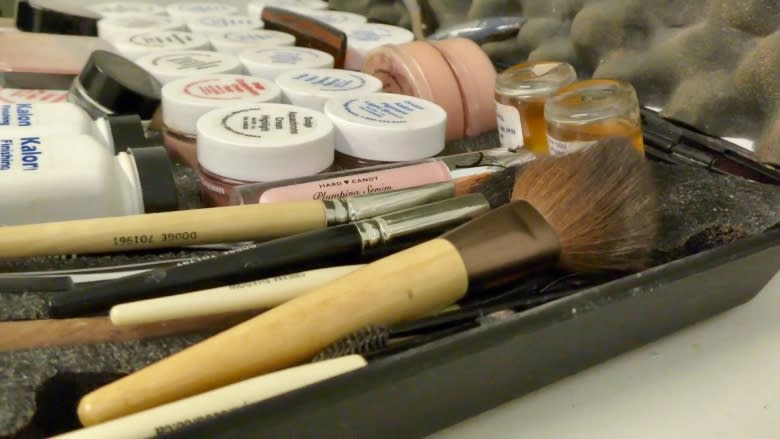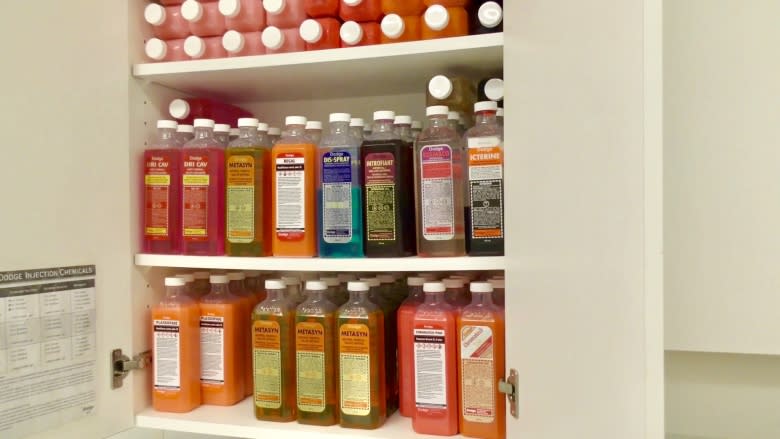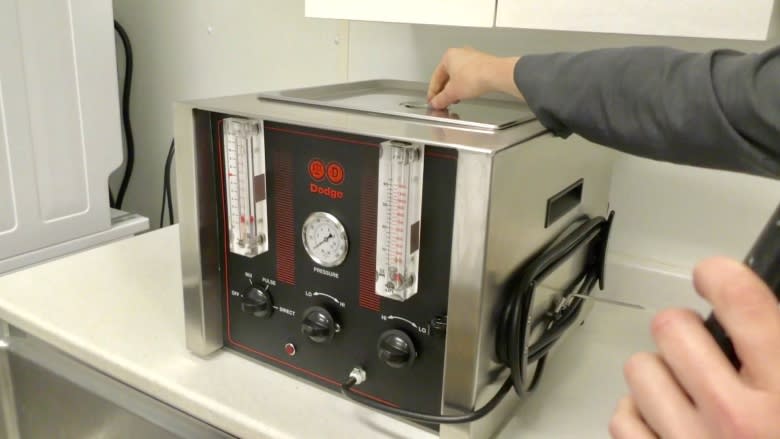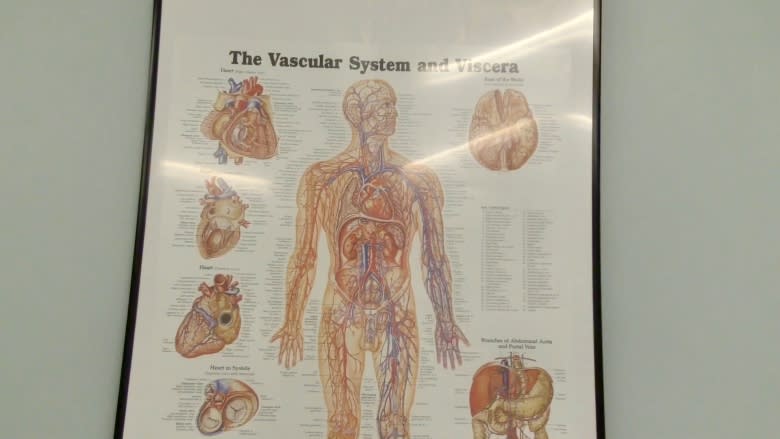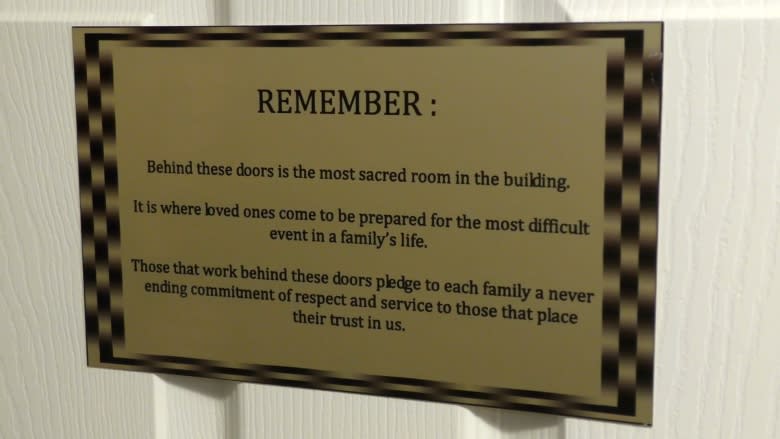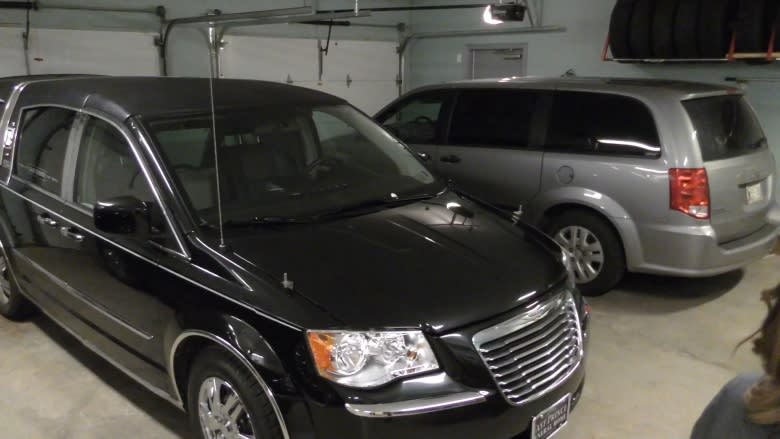Meet Amy Kilbride, embalmer and funeral director
It takes a certain kind of person to spend up to eight hours a day with dead bodies.
But it's a job that embalmer and funeral director Amy Kilbride enjoys.
"The deceased is a vessel where life once existed," she said. "I still treat that person with respect, but the spark that made them who they were, is no longer there."
Kilbride has worked at the East Prince Funeral Home in Summerside, P.E.I. for seven years. She spends most of her time preparing the deceased for funerals, so family and friends can say their final farewells to a loved one.
Many people have an aversion to death and shudder at the thought of even touching a dead person. It takes a special person to do the job.
'What I do, doesn't bother me.'
"There are a lot of jobs I don't think that I would be able to do, like sit at a desk all day and work on a computer," she said.
"But here, just the benefits when the families say thank you to us for doing what we do — what I do, doesn't bother me."
As a kid, Kilbride never had any intentions of working in a funeral home. "Definitely not. It wasn't really on my radar whatsoever," she said. "I didn't have any close family members that had passed away."
Her interest was first sparked in her late 20s while working at an environmental store in Halifax.
Kilbride began researching "green" funerals. "As I started to learn more about it, I started to realize it was something I really wanted to do for a living. So I enrolled in the program and honestly, I couldn't imagine doing anything else."
Suiting up
Kilbride's first duty is to go to the location where the person died in an unmarked van and take the body to the funeral home's embalming room.
The body is lifted onto the embalming table with a hydraulic lift and Kilbride suits up in protective clothing, including gown, apron, shoe covers and gloves.
She removes the deceased's clothing and covers the body with what she calls a dignity blanket. The eyes and mouth are gently closed.
The body is washed and the embalming procedure begins, which temporarily preserves the human tissues. The embalming machine, which acts like a heart, pushes the embalming chemical fluid through the body and forces the blood out through a tube inserted in a vein.
The fluid also kills any diseases within the body. "Public health and safety is a huge concern," Kilbride said.
'We definitely have to protect ourselves'
For privacy reasons, embalmers aren't told the cause of death, for example, whether it was hepatitis C or MRSA. "There are a lot of things that we have to protect ourselves from," she said. "Once the embalming process is complete, that risk is zero to the public, but we definitely have to protect ourselves."
The embalming process takes about two hours and during that time preparations are made to dress the deceased for the funeral.
"While the embalming process is taking place, we actually massage the muscles and move the arms and the legs to relieve any tension or rigor mortis," she said. This reduces stiffness and makes it easier to put clothes on the body.
The final step of the embalming process is called restoration, which includes cosmetics. When someone dies, blood no longer circulates so the deceased are very pale. "We just bring back a little bit of natural colour," Kilbride said.
"When you're in the initial meeting with the family, you get a sense of maybe mom wore a lot of makeup or mom didn't wear any makeup," she said.
"Sometimes family will bring in their own cosmetics because maybe mom had a specific lip colour that she's worn forever and ever and we don't want to change that."
'In case you'd like to touch'
Applying cosmetics, which are specifically designed for the deceased, usually takes about a half-hour.
"Those are finishing powders to help set the cosmetics so in case you'd like to touch the cheek or give a kiss, then it's not going to smudge off," she said.
Finally, the loved one is ready to be placed into the casket for viewing. It's then that Kilbride is rewarded for her work with a simple compliment. "Just, 'Thank you, mom looks like mom', and the family is so pleased and they're put at peace when they are able to honour their loved one."
Kilbride knows how important the appearance of the deceased is to family, and works to ensure she gets it right.
"If dad's always had his hair parted a certain way, and you've always known him like that, and suddenly it's brushed backwards, he doesn't look like dad and that's something we work really hard to perfect."
One of the most difficult aspects of the job is to bury a child. "You just see how much grief the parents are experiencing and it's so relatable to myself as a parent," Kilbride said.
"It's very difficult to maintain your own composure and do the job that you need to do in supporting the family through a really horrible time."
'Part of the human process'
As in life, death has its lighter moments. Kilbride recalled a question she often gets from children, wondering if she removes the legs of the deceased.
"Because when they approach a casket, it's closed from the belly down and they think that their legs are gone. Just disappeared."
Kilbride's 11-year-old daughter isn't thrilled by her mom's choice of profession, but knows she provides an essential service.
"She's not a big fan of what I do, of dying. But she understands that death is a part of life and I've tried to make it a normal part of the human process," said Kilbride.
"She knows I do the embalming and she doesn't like that."
Kilbride says the job can be emotionally overwhelming at times, and though she is good at controlling her feelings, sometimes she can't help it.
"Just random times, but I find that I have enough outlets that I can keep an even keel and do my job," she said.
"At the end of the day, it's the family's grief. It's not my grief," she said. "We are here because the family has asked us to help them through this process and that's kind of how I look at it, so I think that really helps get me through."
More P.E.I. News


